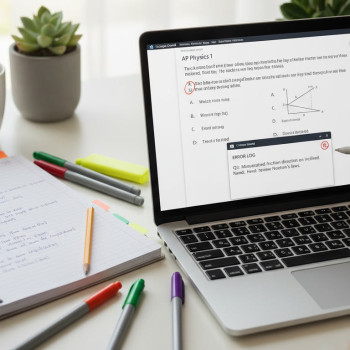What Does “Losing Track of Time” Really Mean for AP Students?
We’ve all been there: you sit down to review your AP Biology notes, open your laptop for a single quick review, and suddenly it’s midnight. Your brain has been somewhere between a video, three tabs, and a half-started practice problem set. For students preparing for College Board AP exams, those vanished hours add up and erode confidence. It’s not just about procrastination — it’s about momentum, attention, and how your mind reacts when stress and task overload collide.
Why recovery matters more than guilt
Guilt feels productive because it stings, but guilt doesn’t help you learn. Recovery scripts — short, actionable routines you run when you discover you’ve lost time — repair momentum and reset your study session. Think of them as the CPR of focus: short, targeted interventions that restore breathing room, clarity, and energy.

How Recovery Scripts Work: The Science in Plain English
Recovery scripts borrow from cognitive psychology and practical productivity. They rely on three principles:
- Interrupt the loop: Change your immediate environment or activity to break the autopilot that swallowed time.
- Reframe the moment: Swap guilt for a tiny, achievable next step so you rebuild momentum.
- Re-anchor attention: Use sensory or structural cues (a timer, a walk, a short checklist) to re-engage working memory and focus.
When you combine these principles into short scripts — 2–10 minute micro-routines — you create reliable ways to regain control without spending energy agonizing over lost time.
Recovery Scripts: Short, Medium, and Deep
Below are three tiers of recovery scripts. Use Short when you notice a drift, Medium when you need to restore a full study block, and Deep when an entire day or week has derailed. Customize language so it feels like you — the more natural it sounds, the more likely you’ll follow it.
Short Script (2–5 minutes): Snap Back
- Stand up, stretch for 30 seconds, breathe in for 4 counts, out for 6 counts.
- Close all tabs except one: pick the single most important resource for the next task (e.g., your practice FRQ, a specific page in your review book).
- Set a 25-minute timer (Pomodoro). Tell yourself: “I will work for 25 minutes on this — then I’ll take a real break.”
- Start with a micro-goal: “Read one paragraph and summarize it in one sentence.”
Why it works: your body and brain get a short physical cue, you remove distractions, and you create an immediate, bite-sized task that’s easy to begin.
Medium Script (10–30 minutes): Regain the Block
- Write a 3-line status update: What did I intend to do? What happened? What’s the next concrete step?
- Rework your session plan: Choose one topic and list 3 activities (example: 15 minutes concept review, 20 minutes practice questions, 5 minutes error logging).
- Use a quick active technique (teach it to an imaginary student, out loud, for 2 minutes).
- Reward yourself after the block with a 10-minute walk or a favorite snack.
Why it works: you get cognitive clarity, rebuild a realistic plan, and pair it with a small, healthy reward so the next block actually feels worthwhile.
Deep Script (30–90 minutes): Reset the Day
- Pause and journal for 5 minutes: What went well today? What derailed me? What one step will salvage the day?
- Re-prioritize: Choose the top 2 exam topics that matter most now — either weak areas or high-point topics on the College Board rubric.
- Create a revised hourly schedule for the next 4–6 hours and block your calendar. Keep tasks concrete and time-bound.
- Text a study buddy or tutor to say, “I’m restarting now — are you up for a 50-minute check-in later?” Accountability helps.
Why it works: the deep script replaces overwhelm with structure and social accountability; it turns a passive, scattered day into an actively managed one.
Example Recovery Scripts for Common AP Moments
Use these scripts as templates and adapt the wording to your voice. Rehearse them — the easier they feel, the faster you’ll use them when panic creeps in.
When a TikTok Spiral Ate an Hour
- 5 deep breaths, stand up, fill a glass of water.
- Set phone to Do Not Disturb for 50 minutes and move it to another room.
- Open your practice packet and do one high-yield active task: one AP-style free-response question (FRQ) or one timed multiple-choice set.
- After the set, mark 3 specific mistakes and one correction strategy.
When You Wake Up and Realize the Day Is Gone
- Start with a 10-minute fresh-air walk to reset your circadian cues.
- Write three achievable evening goals (e.g., finish microreview for Chapter 4, complete 10 practice MCQs, plan tomorrow’s morning review).
- Schedule a wind-down routine to get sleep on track — better sleep is the ultimate recovery.
When Stress Causes Freeze
- Label the emotion out loud: “I feel overwhelmed and stuck.” Naming it lowers anxiety.
- Use a 5-minute grounding technique: list 5 things you can see, 4 you can touch, 3 you can hear, 2 you can smell, 1 you can taste.
- Switch to an easy, confidence-building task: flashcard review, a quick summary, or a short past-question practice.
Practical Tools to Support Your Scripts
Scripts are stronger when paired with tools that make execution frictionless. Here’s a compact table comparing simple tools and how they support recovery scripts.
| Tool | Use Case | How It Supports Recovery |
|---|---|---|
| Timer App (Pomodoro) | Short focus blocks | Creates bounded effort windows and reduces decision fatigue |
| Noise-Cancelling Headphones | Blocked focus time | Physically signals to self and others that you’re in focus mode |
| Paper Planner or Digital Calendar | Daily scheduling | Visual re-prioritization helps salvage time after a derail |
| Accountability Partner or Tutor | Midday check-ins | Social accountability increases follow-through and motivation |
Minimal Setup for Fast Recovery
- Phone on Do Not Disturb and out of reach.
- Timer ready (25/50 minutes) and notebook opened to a single page.
- Water and a quick snack to avoid energy crashes.
How to Write Your Own Recovery Script (A Quick Workshop)
Create a personalized script in five steps. Keep it simple — the aim is execution, not perfection.
- Step 1: Identify Triggers — What usually makes you lose time? Social media? Boredom? Perfectionism? Name three triggers.
- Step 2: Choose a Physical Cue — Stand up, open a window, or move to a different chair. A sensory change breaks autopilot.
- Step 3: Pick a Micro-Goal — One paragraph, 10 flashcards, one FRQ part. Keep it binary: done or not done.
- Step 4: Add a Timer and a Reward — Bound effort and follow with a short, healthy reward.
- Step 5: Script the Language — Write a one-sentence instruction you’ll say to yourself (“Three deep breaths, phone away, 25 minutes on Unit 2 exam questions”).
Sample Personalized Script
Trigger: doomloop of starting multiple review videos.
Script: “Two deep breaths. Phone in the other room. Pomodoro 25 for practice questions. After 25, two-minute stretch and check my errors list.”
How Tutors and Personalized Help Fit In
When recovery scripts are practiced, they’re powerful on their own — but coupling them with tailored support accelerates progress. Personalized tutoring (like Sparkl’s 1-on-1 guidance) can help you:
- Build individualized recovery scripts for your unique triggers and schedule.
- Get expert feedback on practice FRQs and specific strategies for College Board expectations.
- Use AI-driven insights to identify patterns in your practice data and suggest targeted micro-goals.
Working with a tutor can also provide the accountability loop that keeps scripts from being just theory. A weekly check-in transforms small wins into momentum.
Examples: Recovered Sessions That Lead to Big Wins
Stories make strategy relatable. Here are quick case sketches showing how recovery scripts can turn a day around.
Case 1: Emma — From Scroll to Score
Emma found herself endlessly watching review videos without testing herself. Her tutor suggested a Short Script: phone away, 25-minute Pomodoro with 10 APUSH multiple-choice questions, then error logging. Over three weeks, her active practice rose from 20 minutes per day to 60, and her practice-test score improved by 8 percentage points.
Case 2: Jonah — Midday Meltdown to Midday Momentum
Jonah’s afternoons were unproductive. He used the Medium Script: 10-minute walk, a 3-line status note, and a 50-minute targeted study block. Adding a tutor-led weekly review transformed those reclaimed afternoons into reliable study sessions before dinner.
Practical Tips to Keep Scripts Working Long-Term
- Rehearse scripts when you’re calm. They become automatic if practiced in low-stress moments.
- Track recovery incidents for a week: when you lost time, why, and which script helped. Reflection makes the scripts smarter.
- Rotate scripts so they don’t become stale. If Short Script A stops working, try a sensory cue instead of a timer (e.g., a 90-second song to reset).
- Protect your sleep. Recovered study is worthless if you erode cognitive capacity by cutting sleep to squeeze more hours.
Checklist: A Day of Resilience
Use this short checklist every morning to build a day that’s robust to derailment.
- Clear Top 3 Goals for the Day (Concrete & Timed)
- Pre-plan 2 Recovery Scripts (Short + Medium)
- Set Do Not Disturb Windows
- Line up one accountability checkpoint (friend, tutor, or study group)
- Wind-down plan for sleep
Quick FAQ
Q: How often should I run a recovery script?
A: Use them the moment you notice attention drift. Daily rehearsal is ideal — think of it like rehearsing a safety drill.
Q: Aren’t these scripts just tricks? Do they really improve my AP scores?
A: They are simple tools, not magic. But consistency in focused practice is the engine behind score improvement. Recovery scripts help you consistently convert available time into high-quality study time.
Q: What if I keep relapsing into distraction?
A: Layer strategies: environmental setup (phone in another room), social accountability (a tutor or study buddy), and habit-level changes (regular sleep, scheduled breaks). If patterns persist, a tutor can help diagnose the precise bottleneck and tailor scripts accordingly.
Parting Thought: Small Scripts, Big Returns
AP preparation isn’t a single marathon; it’s thousands of tiny sprints. Recovery scripts give you the tools to turn missteps into micro-wins. They keep your practice actually productive, not performative. The next time you notice time has slipped away, resist the reflex to punish yourself — run your script instead. Two minutes of a good reset often beats two hours of guilt.
And if you want guided help building scripts that fit your learning style, consider pairing your practice with tailored tutoring — a short weekly session of 1-on-1 guidance and AI-driven insights can make those two-minute resets stack into big score gains by exam day.

Ready to try a script? Pick one from this post and run it the next time you lose track of time. Treat it like a lab: test, tweak, repeat. Over weeks, you’ll find the scripts that fit your rhythm, preserve your energy, and push your AP scores forward — one rescued study block at a time.
























No Comments
Leave a comment Cancel